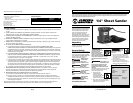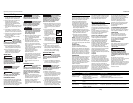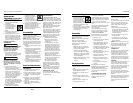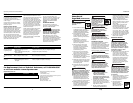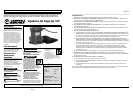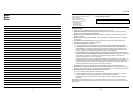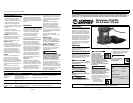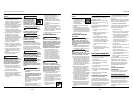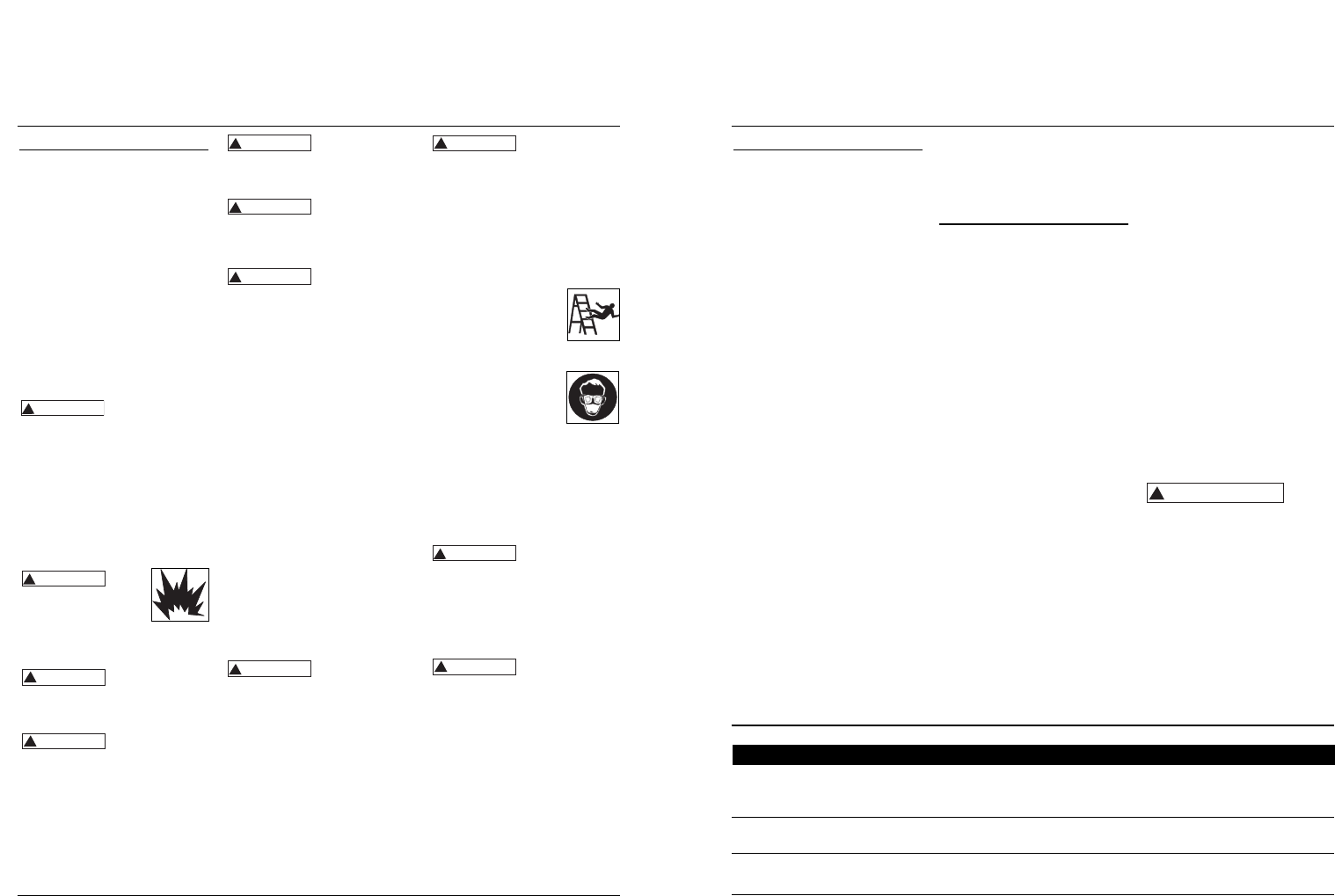
15 Sp
DG480100CK
Funcionamiento
Las lijadoras orbitales están diseñadas
para que la palma de la mano pueda
guiar la herramienta durante el lijado.
Para recoger más polvo, se puede
conectar una aspiradora central
o independiente a la manguera
corrugada de la aspiradora en lugar
de la bolsa de recolección de polvo.
1. Comience a lijar seleccionando el
grano más fino apto para el lijado
inicial. El grano debe ser lo
suficientemente grueso como para
quitar la rebaba y la aspereza excesiva.
2. Cambie el papel de lija a otro con
grano dos números más fino.
3. Continúe el proceso cambiando
sucesivamente a grano más fino
hasta lograr la terminación deseada.
NOTA: no cambie de un papel de lija
con grano grueso a uno con grano muy
fino en un solo paso. Las marcas
circulares que se puedan haber dejado
con el grano grueso pueden ser difíciles
de eliminar.
LIJADO PLANO
La base de su lijadora efectúa
pequeños movimientos circulares.
Gracias a esto obtendrá una superficie
pareja sin marcas. Como el movimiento
que se realiza es circular, no importa
demasiado cómo sostiene y mueve la
lijadora. Por lo general, no es necesario
aplicar presión adicional a la máquina.
TERMINACIÓN
Examine la superficie existente para ver
si está en malas condiciones antes de
quitar la pintura o barniz de puertas,
ventanas y demás. “Malas condiciones”
se refiere a si la capa superior está
suelta o se desprende y la mayor parte
se puede quitar fácilmente con un
cepillo o rasqueta.
Lije la superficie hasta que esté plana,
elimine todas las manchas y déjela lo
suficientemente expuesta antes de
aplicar la nueva capa de pintura o
barniz.
Primero use un papel de lija grueso
para pulir la superficie dura de la capa
anterior. Luego use un papel más fino
para preparar la superficie para la
nueva capa de pintura o barniz.
Mantenimiento
El servicio de la herramienta debe ser
realizado sólo por personal de
reparaciones calificado. El servicio o
mantenimiento realizado por personas
no calificadas puede provocar riesgo de
lesiones.
Si la herramienta no enciende o no
funciona correctamente, devuelva la
herramienta a una instalación de
servicios para repararla.
Cambio de escobillas de carbón
Retire y verifique las escobillas de
carbón regularmente. Cámbielas
cuando se desgasten hasta la marca
límite. Mantenga las escobillas de
carbón limpias y libres para que se
deslicen en los soportes. Ambas
escobillas de carbón deben cambiarse
al mismo tiempo. Use únicamente
escobillas de carbón idénticas.
Use un destornillador para retirar las
tapas de los soportes de las escobillas.
Quite las escobillas de carbón
desgastadas, introduzca las nuevas y
asegure las tapas de los soportes de las
escobillas.
Limpieza
Limpie el polvo y los desechos de
los orificios y contactos eléctricos,
soplando con aire comprimido.
Los orificios de ventilación del motor
y los interruptores deben mantenerse
limpios y libres de materiales extraños.
No intente limpiarla introduciendo
objetos con punta a través de las
aberturas. Mantenga los mangos de las
herramientas limpios, secos y libres de
aceite o grasa. Use únicamente un
jabón suave y un paño húmedo para
limpiar la herramienta, evitando todos
los contactos eléctricos.
Ciertos agentes de limpieza y solventes
son nocivos para los plásticos y otras
piezas aisladas. Algunos de éstos
incluyen gasolina, aguarrás, solvente
para laca, solvente de pintura,
solventes de limpieza con cloro,
amoníaco y detergentes de uso
doméstico que contengan amoníaco.
Nunca use solventes inflamables ni
combustibles cerca de las
herramientas.
LA HERRAMIENTA NO FUNCIONA
En caso de que la herramienta no
funcione, asegúrese de que la batería
esté cargada e instalada en la sierra.
LUBRICACIÓN
Para su seguridad y protección
eléctrica continuas, la lubricación
y elservicio de esta herramienta
deberán ser realizadas ÚNICAMENTE
por un CENTRO DE SERVICIO
AUTORIZADO DE CAMPBELL
HAUSFELD.
SERVICIO TÉCNICO
Para obtener información con relación
al funcionamiento o reparación de
este producto, sírvase llamar al
1-800-424-8936.
Elservicio de la herramienta debe
serrealizado sólo por personal de
reparaciones calificado. El servicio
omantenimiento realizado por personas
no calificadas puede provocar riesgo de
lesiones.
Al realizarle un servicio a la
herramienta, utilice únicamente piezas
de repuesto idénticas. Siga las
instrucciones de la sección
Mantenimiento de este manual. El uso
de piezas no autorizadas o el no seguir
las instrucciones de Mantenimiento
puede crear un riesgo de choque
eléctrico o lesión.
!
PRECAUCION
Tabla de diagnóstico de problemas
Síntoma Causa(s) posible(s) Acciones a tomar
Vibración o ruidos
excesivos al lijar
La herramienta no
se apaga
No recoge polvo
eficientemente
1. Almohadilla de lijado incorrecta,
dañada o gastada
2. Piezas internas y/o rodamientos
gastados o dañados
Válvula de aire o asiento gastados
o sucios
1. Baja presión de aire
2. Retorno del accesorio de salida
gastado o dañado
1.Reemplácela por una almohadilla correcta
(tamaño, peso y estilo)
2.Inspecciónelos y reemplácelos si fuera necesario
Límpielos y reemplácelos si fuera necesario
1.Aumente la presión del aire
2.Límpielo, inspecciónelo y reemplácelo si fuera necesario
General Safety (Cont’d.)
5. Always use attachments designed
for use with this tool. Do not use
damaged or worn attachments.
6. Never trigger the tool when not
applied to a work object.
Attachments must be securely
attached. Loose attachments can
cause serious injury.
7. Never point a tool at oneself or any
other person. Serious injury could
occur.
8. Use steady, even pressure when
using tool. Do not force. Too much
pressure can cause tool to overheat.
9. Keep all nuts, bolts and screws tight
and ensure equipment is in safe
working condition.
10.Do not put hands near or under
moving parts.
Check sanding
pad for cracks and
wear prior to use. Replace if damaged.
A damaged pad can break apart during
use and cause serious injury.
11.Ensure sandpaper is fully sealed
onto sanding pad and that pad is
securely tightened to tool spindle.
12.Do not free spin tool. Acuate
trigger just before engaging work
surface and release trigger when
lifting tool away from surface.
WORK AREA
Do not
operate a power tool in an
explosive atmosphere, such
as in the presence of
flammable liquids, gases, or dust.
Power tools create sparks which may
ignite the fumes or dust.
Keep work area
clean and well lighted. Cluttered
benches and dark areas invite
accidents.
Keep bystanders,
children, and visitors away while
operating a power tool. Distractions
can cause you to lose control.
ELECTRICAL SAFETY
Double insulated tools are equiped with
a polarized plug (one plug blade is wider
that the other). this plug will fit in a
polarized outlet only one way. If the plug
does not fit fully into the outlet, turn the
plug over and insert into plug again.
!
CAUTION
!
CAUTION
!
WARNING
!
WARNING
2
Operating Instructions and Parts Manual
Avoid accidental
starting. Be sure switch is in the locked
or off position before making any
adjustments, changing accessories, or
storing the tool. Carrying tools with
your finger on the switch with the
switch on invites accidents.
2. Remove adjusting keys or wrenches
before turning on the tool. A key or
wrench attached to a rotating part
of the tool may result in personal
injury.
3. Do not overreach. Keep
proper footing and
balance at all times.
Proper footing and
balance enable better
control of the tool in unexpected
situations.
4. Always work in a well-
ventilated area. Wear an
OSHA-approved dust
mask and safety glasses.
5. Keep hands away from rotating
parts.
6. Use clamps or another practical
way to secure the workpiece to a
stable platform. Never hold work in
your hand, lap, or against other
parts of your body when cutting.
TOOL USE AND CARE
Do not use tool if
switch does not turn it on or off. Any
tool that cannot be controlled with the
switch is dangerous and must be
repaired.
1. This tool must NOT be modified or
used for any application other than
that for which it was designed.
Do not force the
tool. Use the correct tool for your
application. The correct tool will do the
job better and safer at the rate for
which it is designed.
2. Maintain tools with care.
3. Check for misalignment or binding
of moving parts, breakage of parts,
and any other condition that may
affect the tool’s operation. If
damaged, have the tool serviced
before using. Many accidents are
caused by poorly maintained tools.
4. Use only accessories that are
recommended by the manufacturer
for your model. Accessories suitable
for one tool may create a risk of
injury when used on another tool.
!
CAUTION
!
WARNING
!
CAUTION
Do not expose
power tools to rain or wet conditions.
Water entering a power tool will
increase the risk of electric shock.
Avoid body contact
with grounded surfaces such as pipes,
radiators, ranges, and refrigerators.
There is an increased risk of electric
shock if your body is grounded.
Do not abuse cord.
• Never carry charger by its cord.
• Never pull the cord to disconnect
from receptacle. Pull charger case
rather than cord when
disconnecting charger.
1. Make sure cord is located so that it
will not be stepped on, tripped
over, or otherwise subjected to
damage or stress.
2. Do not use an extension cord unless
absolutely necessary. Use of
improper extension cord could
result in a risk of fire and electric
shock. If an extension cord must be
used, make sure:
• That the pins on plug of extension
cord are the same number, size and
shape as those of plug.
• That the extension cord is
properly wired and in good
electrical condition.
• If an extension cord is to be used
outdoors it must be marked with
the suffix “W-A” or “W” following
the cord type designation to
indicate it is acceptable for outdoor
use. For example – SJTW-A
3. Do not expose to rain, snow or
frost.
PERSONAL SAFETY
Do not misuse this
product. Excessive exposure to
vibration, work in awkward positions,
and repetitive work motions can cause
injury to hands and arms. Stop using
any tool if discomfort, numbness,
tingling, or pain occur, and consult a
physician.
1. Stay alert, watch what you are
doing, and use common sense when
operating a power tool. Do not use
tool while tired or under the
influence of drugs, alcohol, or
medication. A moment of
inattention while operating power
tools may result in serious personal
injury.
!
WARNING
!
WARNING
!
WARNING
!
WARNING
www.chpower.com



